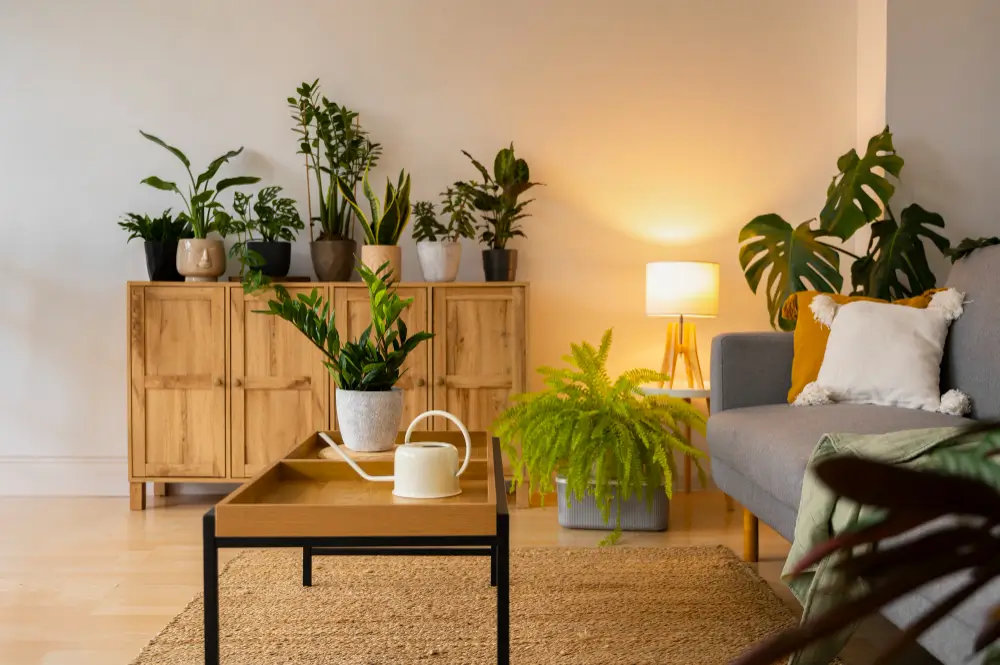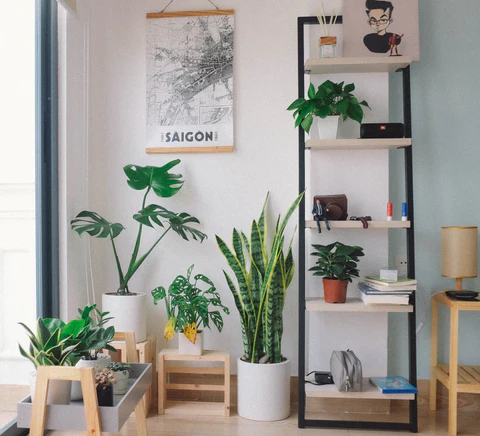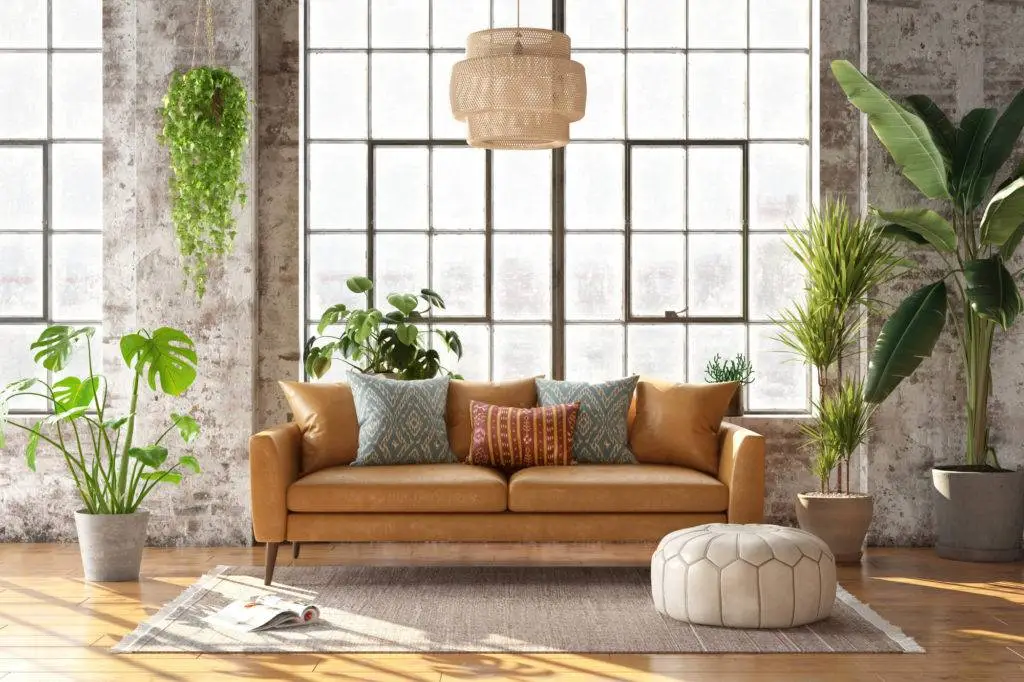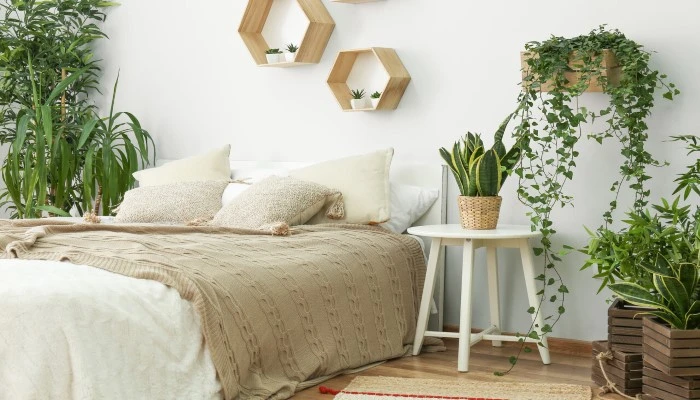Contents
Introduction
Welcome to your ultimate guide on how to incorporate indoor plants into your apartment decor! If you’ve ever wondered how a few green friends can transform your living space, you’re in the right place. Not only do indoor plants add a splash of nature to your home, but they also come with a bunch of perks that go beyond just looking pretty.
Why Bother with Indoor Plants?
First off, let’s talk about why you might want to consider adding some plants to your apartment. Plants are more than just decor—they’re natural air purifiers. They help filter out toxins from the air and give off fresh oxygen, which can make your space feel cleaner and more vibrant. It’s like having a mini rainforest right in your living room!
But that’s not all. Research shows that having plants around can actually help reduce stress and boost your mood. Imagine coming home after a long day to a space filled with lush greenery—it’s not just visually soothing, but it can actually make you feel more relaxed and happy. Plus, taking care of plants can be surprisingly therapeutic, giving you a chance to unwind and connect with nature.
What’s Inside This Guide?
In this guide, we’ll walk you through everything you need to know about adding plants to your apartment. We’ll start with how to choose the right plants based on your living conditions, from how much light your space gets to how much time you can commit to plant care. Then, we’ll dive into creative ways to display your plants so they not only fit perfectly into your space but also enhance your overall decor.
We’ll also cover how to pick the best pots and containers to match your style, as well as essential tips on keeping your plants healthy and thriving. Whether you’re a plant newbie or just looking for fresh ideas, this guide will help you turn your apartment into a green oasis.
So, grab a cup of coffee, get comfy, and let’s dig into the wonderful world of indoor plants. Your apartment is about to get a whole lot greener and a lot more inviting!
Choosing the Right Indoor Plants
Alright, now that you’re excited about bringing some greenery into your apartment, let’s get down to the nitty-gritty of choosing the right plants. This part is crucial because not all plants are created equal, and picking the right ones can make your life a whole lot easier.

Assessing Light Conditions
First things first: light. Plants need different amounts of sunlight to thrive, so figuring out how much light your space gets is key. Don’t worry if you’re not a lighting expert—here’s a simple breakdown:
- Low Light Plants: If your apartment doesn’t get much direct sunlight, no problem! There are plenty of plants that are happy with just a bit of indirect light. Think about getting a Snake Plant, Pothos, or ZZ Plant. These guys are super low-maintenance and can survive in those shady spots of your home.
- Bright, Indirect Light Plants: For those sunny spots where the light is strong but not directly hitting the plant, you have a wide range of options. Spider Plants, Peace Lilies, and Philodendrons love this kind of environment and will flourish in your bright, airy rooms.
- Direct Sunlight Plants: If you’re lucky enough to have a sun-soaked area in your apartment, consider adding Succulents or Cacti. These plants thrive on the intense sunlight and will love the warm, sunny spots in your home.
Considering Space and Size
Next up is space. Think about where you want to put your plants and how much room you have. Here’s a quick guide to help you choose:
- Small Spaces: If you’re working with limited room, go for smaller plants like Air Plants or little Succulents. They don’t take up much space and can fit into tight spots like windowsills or small shelves.
- Medium Spaces: For more room to play with, consider Medium-sized plants like Ferns or Rubber Plants. They’re perfect for adding a touch of greenery without overwhelming your space.
- Large Spaces: Got a big area that needs some love? Large plants like Monstera or Fiddle Leaf Figs can make a dramatic statement and fill up empty corners with lush greenery.
Personal Preferences and Maintenance
Finally, think about your own style and how much time you want to spend caring for your plants. There’s a plant out there for every preference:
- Low-Maintenance Plants: If you’re not the greenest thumb or just don’t have much time, go for Low-Maintenance plants like Aloe Vera or Jade Plant. They’re hardy and don’t need constant attention.
- High-Maintenance Plants: If you’re up for a bit more of a challenge and enjoy plant care, try High-Maintenance plants like Orchids or Calatheas. They might require a bit more love and attention but can be incredibly rewarding.
- Allergies and Pets: If you have allergies or pets, make sure to choose Non-Toxic plants. Some plants can be harmful if ingested by pets, so it’s best to pick safe options.
So, before you rush out to buy your plants, take a moment to consider your space, light conditions, and how much care you’re willing to give. With the right choices, you’ll have a thriving indoor garden that fits perfectly into your apartment lifestyle.
Plant Placement and Arrangement
Now that you’ve picked out the perfect plants for your apartment, it’s time to figure out where they’ll go and how to display them. Proper placement and creative arrangement can really make your plants pop and enhance your overall decor. Let’s dive into some fun and practical ways to showcase your green buddies!

Enhancing Different Areas
First, think about how plants can brighten up different parts of your apartment:
- Living Room: This is often the heart of your home, so it’s a great place for some eye-catching plant displays. Try creating a plant corner with larger plants like a Monstera or Rubber Plant to make a bold statement. You can also place plants on side tables or shelves to add layers and depth to your decor.
- Bedroom: For a calming and restful atmosphere, choose plants known for their air-purifying qualities. Snake Plants or Lavender can help promote better sleep and make your bedroom feel more serene. Place them on nightstands, windowsills, or even hang them near your bed for a soothing touch.
- Kitchen: Your kitchen can benefit from fresh herbs or small, hardy plants. Herbs like basil or mint can be grown on windowsills for easy access when cooking. Small plants like Spider Plants or Pothos can also thrive in the kitchen, adding a touch of greenery without taking up too much space.
Creative Plant Displays
Now for some fun ways to display your plants creatively:
- Shelving Units: Use shelves to arrange your plants at different heights. This creates a dynamic display and lets you show off a variety of plants. You can mix and match plant sizes and types for a visually interesting setup.
- Hanging Planters: If floor space is limited, try hanging your plants! Macrame hangers or wall-mounted planters can add a stylish boho vibe and keep your plants out of the way. Hang them at various heights to create a cascading effect.
- Plant Stands: Elevate your plants with stands to give them more presence in a room. Plant stands come in various styles, from sleek modern to rustic, so you can find one that complements your decor. They’re also great for making smaller plants stand out.
Integrating Plants with Furniture
Lastly, think about how your plants can work with your existing furniture:
- Plant and Furniture Harmony: Choose plants that match or contrast with your furniture style. For a modern look, go for sleek, minimalistic pots. For a more eclectic space, mix different plant styles and pots for a playful effect.
- Color Coordination: Match your plant pots with the color scheme of your room. You can use pots that blend with your decor or go for bold, contrasting colors to make your plants pop. This adds a cohesive touch to your design and ties everything together.
By considering where and how you place your plants, you can create a visually appealing and functional arrangement that enhances your apartment’s decor. Whether you’re going for a lush, green corner or a stylish hanging display, these tips will help you showcase your plants in the best way possible.
Choosing and Styling Plant Containers
Now that you’ve got your plants and know where to put them, it’s time to pick out the perfect containers. The right pot can make a huge difference in how your plants look and how well they thrive. Let’s explore how to choose and style plant containers to match your space and style!

Selecting Containers
When it comes to choosing pots, there are a few key things to keep in mind:
- Material Options: Plant containers come in a variety of materials, each with its own look and benefits. Ceramic pots add a classic touch and come in lots of colors and patterns. Terracotta pots are great for a rustic or natural feel and are super breathable for plant roots. Plastic pots are lightweight and often come in fun, bright colors, while metal pots can add an industrial edge to your decor.
- Size and Drainage: Make sure your containers are the right size for your plants. A pot that’s too small can restrict growth, while one that’s too large might lead to overwatering. Also, check for drainage holes. Proper drainage is crucial to prevent root rot and keep your plants healthy.
Decorating Pots and Planters
Once you’ve picked your containers, it’s time to get creative:
- DIY Pot Decorating: Personalize your plant pots with DIY projects. You can paint them in your favorite colors, wrap them with fabric or yarn, or add decals to give them a unique touch. It’s a fun way to match your pots with your decor and show off your personality.
- Pot Styles: Choose pots that fit your room’s aesthetic. For a modern look, go for sleek, minimalist designs. If your decor is more rustic, opt for earthy, textured pots. For a bohemian vibe, try colorful, patterned containers or macramé hangers.
Grouping Plants and Containers
Arranging multiple plants and pots can create a cohesive and stylish look:
- Cohesive Looks: If you like a unified appearance, use matching or complementary pots for all your plants. This can help create a clean, organized look, especially if you’re grouping plants together on shelves or tables.
- Varying Heights and Shapes: Mix and match different heights and shapes of pots to add visual interest. Use taller pots for larger plants and shorter ones for smaller varieties. This variation helps create a dynamic display and keeps your plant arrangement from looking too uniform.
Choosing and styling your plant containers is all about finding a balance between function and aesthetics. With the right pots, you’ll not only enhance the look of your plants but also ensure they have the right environment to thrive. So, have fun picking out containers that reflect your style and make your green friends look their best!
Care and Maintenance
With your plants selected and stylishly displayed, the next step is keeping them happy and healthy. Plant care might sound a bit daunting, but don’t worry—it’s pretty straightforward once you get the hang of it. Let’s go through the basics of watering, feeding, pruning, and managing pests to keep your indoor garden thriving.
Watering and Feeding
The key to healthy plants is getting their watering and feeding just right:
- Watering Frequency: Different plants have different water needs, so it’s essential to understand how often each plant requires a drink. Generally, most indoor plants prefer their soil to dry out slightly between waterings. A good rule of thumb is to check the top inch of soil—if it’s dry, it’s time to water. Overwatering is a common mistake, so make sure your pots have good drainage to avoid root rot.
- Fertilizing: Plants need nutrients to grow strong and vibrant. Fertilizers provide these nutrients, but you don’t need to overdo it. Use a balanced, all-purpose fertilizer or one specific to your plant type. Follow the instructions on the package for the right amount and frequency—usually, feeding once a month during the growing season is sufficient.
Pruning and Repotting
To keep your plants looking their best and ensure they have room to grow, follow these tips:
- Pruning: Regular pruning helps maintain the shape of your plants and removes any dead or yellowing leaves. This not only keeps your plants looking tidy but also encourages new growth. For most plants, a quick trim of overgrown stems or leaves every few weeks is all they need. Be sure to use clean, sharp scissors or pruning shears to avoid spreading diseases.
- Repotting: As your plants grow, they may outgrow their pots and need a new home. Repotting involves moving your plant to a larger container with fresh soil. This helps prevent root binding and provides more space for your plant to expand. Generally, repot plants every 1-2 years or when you notice they’ve become root-bound.
Pest and Disease Management
Keeping your plants healthy means keeping an eye out for pests and diseases:
- Common Pests: Indoor plants can attract pests like spider mites, aphids, or mealybugs. Look for signs like tiny webs, sticky residue, or visible bugs on your plants. Treat infestations promptly with insecticidal soap, neem oil, or by gently washing the pests off with water. Regularly inspecting your plants can help catch problems early.
- Preventive Measures: To avoid pest issues, keep your plants clean and healthy. Avoid overwatering, which can lead to mold and mildew, and ensure good air circulation around your plants. Quarantine new plants before introducing them to your collection to prevent any potential pests or diseases from spreading.
Caring for your plants might seem like a lot of work, but once you get into a routine, it becomes second nature. By keeping up with watering, feeding, pruning, and pest control, you’ll ensure your indoor garden stays lush and beautiful. Enjoy the process and the satisfaction of seeing your plants thrive!
Incorporating Plants into Different Decor Styles
Now that you’ve got your plants and know how to care for them, it’s time to make them a seamless part of your decor. Plants can fit into any design style, from modern to bohemian, and knowing how to integrate them can elevate your space. Let’s explore how to incorporate plants into various decor styles to match your home’s aesthetic.
Modern Decor
If your home leans toward a sleek, contemporary style, here’s how to blend plants into your modern decor:
- Minimalist Planters: Go for simple, clean-lined pots that match the minimalist vibe. Think neutral colors like white, black, or grey, and materials like ceramic or concrete. These understated containers let the greenery take center stage without overwhelming the space.
- Geometric Displays: Modern decor often features geometric shapes, so why not incorporate this into your plant displays? Use geometric planters or arrange your plants in visually striking patterns. This adds a stylish touch while maintaining the modern aesthetic.
Bohemian Style
For a more eclectic and relaxed vibe, plants can enhance your bohemian decor beautifully:
- Macramé Hangers: Add a boho touch with macramé plant hangers. These woven hangers come in various styles and colors and can hang from ceilings or walls, creating a cascading effect. They’re perfect for showcasing trailing plants like Pothos or String of Pearls.
- Eclectic Mix: Embrace variety with a mix of plant types and pot styles. Use colorful, patterned pots, and pair them with a diverse array of plants. This eclectic approach adds personality and charm, fitting perfectly with a bohemian decor theme.
Industrial Style
If your space has an industrial edge with raw materials and urban influences, plants can still play a stylish role:
- Metal Containers: Choose plant pots made from metals like copper, steel, or iron. These materials complement industrial decor and add a sleek, modern touch. Look for containers with industrial finishes or rustic patinas to match your decor.
- Contrast with Hard Surfaces: Use plants to soften the hard, edgy elements of industrial decor. Place them in corners or on surfaces with concrete or metal finishes. The greenery provides a fresh contrast to the tougher elements of industrial style, creating a balanced and inviting space.
Scandinavian Style
Scandinavian decor is known for its simplicity and focus on natural elements, which makes plants a natural fit:
- Neutral Pots: Stick to pots in neutral colors like white, beige, or muted pastels. These colors blend seamlessly with the light, airy feel of Scandinavian design. Materials like ceramic or light wood can also complement this style.
- Clean Lines and Functional Displays: Keep plant displays simple and functional. Use sleek plant stands or wall-mounted planters to maintain the clean lines characteristic of Scandinavian decor. This approach keeps the space uncluttered while showcasing your plants elegantly.
Incorporating plants into your decor style can elevate your space and enhance its overall feel. Whether you’re going for a modern, bohemian, industrial, or Scandinavian look, there’s a way to make your plants blend beautifully with your design. So, take these tips and let your plants become an integral part of your home’s style!
Seasonal Considerations
Plants are a year-round commitment, but their needs and your approach to their care can change with the seasons. Understanding how to adapt your plant care routine to different times of the year will keep your indoor garden looking great no matter the weather outside. Let’s explore how to adjust your plant care for each season and choose the right plants for different times of the year.
Seasonal Plant Care
Adjusting your plant care routine can help your plants thrive throughout the year:
- Winter Care: During the winter months, indoor heating can dry out the air, so be mindful of your plants’ moisture needs. Water less frequently, as plants typically grow more slowly and require less water in cooler months. Consider using a humidifier or placing a tray of water near your plants to add moisture to the air. Also, ensure that your plants are not placed near drafts or direct hot air from heaters, which can stress them.
- Summer Care: In summer, plants usually need more water due to increased heat and sunlight. Check the soil more frequently and water as needed, but be careful not to overwater. Also, consider rotating your plants regularly to ensure even light exposure and avoid sunburn on one side. If possible, provide some shade for plants that are sensitive to direct sunlight, especially during the hottest part of the day.
Seasonal Plant Choices
Selecting the right plants for each season can enhance your home’s ambiance and keep things fresh:
- Spring/Summer: Spring and summer are great times to experiment with flowering plants and fresh herbs. Plants like Geraniums, Petunias, or Begonias can add vibrant colors to your space. Fresh herbs like Basil, Mint, or Cilantro thrive during these warmer months and can be a handy addition to your kitchen. It’s also a good time to consider adding new plants or rearranging your current ones to make the most of the increased natural light.
- Fall/Winter: In fall and winter, focus on hardy plants that can handle lower light levels and cooler indoor temperatures. Plants like Poinsettias, Christmas Cacti, or Aloe Vera are well-suited for these seasons. It’s also a good time to shift your focus to indoor plants that can bring a touch of greenery and warmth to your home. Consider using evergreen plants or those with rich, deep colors to create a cozy and inviting atmosphere.
By adjusting your plant care routine and choosing seasonal plants, you can keep your indoor garden thriving throughout the year. Embrace the changes that each season brings and let your plants add a touch of seasonal charm to your home. Whether it’s a burst of summer blooms or the cozy greenery of winter, there’s always a way to keep your indoor garden vibrant and enjoyable.
Conclusion
You’ve made it through the essentials of incorporating indoor plants into your apartment decor, and now it’s time to wrap things up. Here’s a quick recap and some final thoughts to help you make the most of your green space.
Recap of Key Points
- Choosing the Right Plants: We’ve covered how to pick plants that fit your apartment’s light conditions, space, and your level of commitment. Whether you’re looking for low-maintenance options or something more vibrant, there’s a plant out there for every space and lifestyle.
- Placement and Styling: From enhancing different areas of your home to creative plant displays, you’ve learned how to integrate plants into your decor seamlessly. Using shelves, hanging planters, and plant stands can help you showcase your plants in style.
- Containers and Pots: You now know how to choose and style plant containers to match your decor. Whether you prefer minimalist or eclectic designs, the right pots can make a huge difference in your plant displays.
- Care and Maintenance: Keeping your plants healthy involves proper watering, feeding, pruning, and pest management. With these tips, you’ll be able to maintain a lush and thriving indoor garden.
- Decor Styles: Plants can fit into any decor style, from modern and industrial to bohemian and Scandinavian. By matching your plants and pots with your room’s aesthetic, you can enhance your space beautifully.
- Seasonal Considerations: Adapting your plant care and choosing seasonal plants can keep your indoor garden vibrant throughout the year. Each season offers new opportunities to refresh your space and keep things interesting.
Encouragement to Experiment
Now that you’ve got the basics down, don’t be afraid to experiment and have fun with your plants. Try out different plant combinations, play with various pot styles, and see what works best in your space. Remember, there’s no one-size-fits-all approach, and your indoor garden should reflect your personal style and preferences.
Enjoy the Process
Incorporating plants into your apartment is not just about the end result but also about enjoying the process. Watching your plants grow and thrive can be incredibly rewarding. Plus, they add a touch of nature and tranquility to your home, making it feel more inviting and lively.
So go ahead—get creative, explore new plant varieties, and embrace the joy of indoor gardening. With these tips and a little bit of care, your apartment will become a beautiful green sanctuary you can enjoy year-round. Happy planting!



